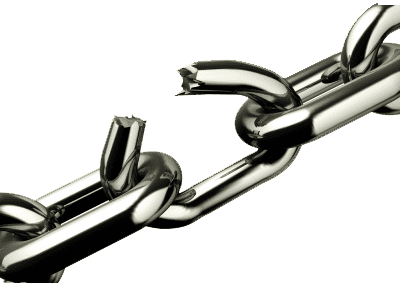 It has often been said: “A chain is only as strong as its weakest link.” [tweet this] This is true. Regardless of how fortified the individual links are, when the chain is stressed under a load, the breaking point will be the weakest link. The same can be said of situational awareness at an emergency scene. Each member of the team is a link in the proverbial chain. The load at an emergency incident is workload and stress (physical and emotional). When situational awareness breaks down, the entire team is vulnerable.
It has often been said: “A chain is only as strong as its weakest link.” [tweet this] This is true. Regardless of how fortified the individual links are, when the chain is stressed under a load, the breaking point will be the weakest link. The same can be said of situational awareness at an emergency scene. Each member of the team is a link in the proverbial chain. The load at an emergency incident is workload and stress (physical and emotional). When situational awareness breaks down, the entire team is vulnerable.
I make this point because the audiences in my Situational Awareness and Decision-Making classes are often senior staff and company officers – the decision makers and commanders. For whatever reason, the line personnel are often left out (maybe it’s a financial constraint – I’m not judging, just observing). Ironically, when the program is over I often receive feedback that includes: “Everyone in our department needs to be trained on this material.”
Indeed! The emergency scene can become a very frustrating – not to mention an extremely dangerous – place if any responder is operating with under-developed situational awareness. The high stress, time-constrained incident scene is no place to teach situational awareness. But it is the place where flawed situational awareness contributes to bad outcomes.
The fundamentals of situational awareness and decision-making (and the human behavior that contributes to success and failure) are best taught in a calm, low-stress classroom environment. This includes EVERYONE, not just commanders and officers. If the newest firefighter operating at an emergency scene has flawed situational awareness, it may jeopardize scene safety.
Developing the situational awareness of the newest responders can be especially challenging because they have so much to learn. It pains me to talk to young responders and ask them about their training. They tell me about how they have been trained as firefighters, rescue technicians, HAZMAT specialists, EMTs, and paramedics. When I ask them about their training on situational awareness and decision-making you can hear the crickets in the room. A responder who lacks the understanding of how to develop and maintain situational awareness is a weak link.
Chief Gasaway’s Advice
 The solution to this problem, while simple, may not be easy. Simply, all responders need to be trained on how to develop and maintain strong situational awareness. What keeps this from being easy is those people who would be the teachers of this topic do not understand enough about the topic to be a good teacher. Situational awareness is more than paying attention. It takes me two full days to comprehensively teach a class on situational awareness and decision-making. TWO DAYS!
The solution to this problem, while simple, may not be easy. Simply, all responders need to be trained on how to develop and maintain strong situational awareness. What keeps this from being easy is those people who would be the teachers of this topic do not understand enough about the topic to be a good teacher. Situational awareness is more than paying attention. It takes me two full days to comprehensively teach a class on situational awareness and decision-making. TWO DAYS!
My situational awareness and decision-making classes do not focus on strategy and tactics. In fact, I never talk once about tactical performance. There are plenty of other people out there on a local level who are good tactical instructors who can teach that. Teaching situational awareness and decision-making is a specialty topic. [tweet this] Make sure ALL your responders are being properly taught about situational awareness from an instructor who possesses a deep understanding of how to develop and maintain situational awareness, how it can be lost, and how it can be regained if it is lost.
Action Items
 1. Share your understanding of how situational awareness is developed, maintained, lost, and regained.
1. Share your understanding of how situational awareness is developed, maintained, lost, and regained.
2. Describe the training you received on how to develop and maintain situational awareness.
3. Discuss how you identify your weak links as they relate to situational awareness and the process your department uses to fix these challenges.
_____________________________________________________________
The mission of Situational Awareness Matters is simple: Help first responders see the bad things coming… in time to change the outcome.
Safety begins with SA!
_____________________________________________________________
Share your comments on this article in the “Leave a Reply” box below. If you want to send me incident pictures, videos or have an idea you’d like me to research and write about, contact me. I really enjoy getting feedback and supportive messages from fellow first responders. It gives me the energy to work harder for you.
Thanks,

Email: Support@RichGasaway.com
Phone: 612-548-4424
Facebook Fan Page: www.facebook.com/SAMatters
Twitter: @SAMatters
LinkedIn: Rich Gasaway
YouTube: SAMattersTV
iTunes: SAMatters Radio

